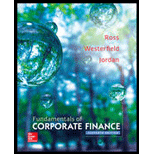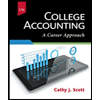
Fundamentals of Corporate Finance
11th Edition
ISBN: 9780077861704
Author: Stephen A. Ross Franco Modigliani Professor of Financial Economics Professor, Randolph W Westerfield Robert R. Dockson Deans Chair in Bus. Admin., Bradford D Jordan Professor
Publisher: McGraw-Hill Education
expand_more
expand_more
format_list_bulleted
Concept explainers
Textbook Question
Chapter 15.2, Problem 15.2ACQ
What are the basic procedures in selling a new issue?
Expert Solution & Answer
Want to see the full answer?
Check out a sample textbook solution
Students have asked these similar questions
Do not answer wit incorrect values i will unhelpful!
What are the implications of missing a credit card payment in finance?
Omni Advisors, an international pension fund manager, uses the concepts of purchasing power parity (PPP) and the International Fisher Effect (IFE) to forecast spot exchange rates. Omni gathers the financial information as follows: Base price level 100 Current U.S. price level 105 Current South African price level 111 Base rand spot exchange rate $ 0.188 Current rand spot exchange rate $ 0.171 Expected annual U.S. inflation 7% Expected annual South African inflation 5% Expected U.S. one-year interest rate 10% Expected South African one-year interest rate 8% Required:
a. The current ZAR spot rate in USD that would have been forecast by PPP.Note: Do not round intermediate calculations. Round your answer to 4 decimal places.
b. Using the IFE, the expected ZAR spot rate in USD one year from now.Note: Do not round intermediate calculations. Round your answer to 4 decimal places.
c. Using PPP, the expected ZAR spot rate in USD four years from now.Note: Do not round intermediate calculations.…
Chapter 15 Solutions
Fundamentals of Corporate Finance
Ch. 15.1 - Prob. 15.1ACQCh. 15.1 - Prob. 15.1BCQCh. 15.2 - What are the basic procedures in selling a new...Ch. 15.2 - What is a registration statement?Ch. 15.3 - Prob. 15.3ACQCh. 15.3 - Why is an initial public offering necessarily a...Ch. 15.4 - Prob. 15.4ACQCh. 15.4 - Prob. 15.4BCQCh. 15.5 - Prob. 15.5ACQCh. 15.5 - Suppose a stockbroker calls you up out of the blue...
Ch. 15.6 - What are some possible reasons why the price of...Ch. 15.6 - Explain why we might expect a firm with a positive...Ch. 15.7 - What are the different costs associated with...Ch. 15.7 - What lessons do we learn from studying issue...Ch. 15.8 - Prob. 15.8ACQCh. 15.8 - What questions must financial managers answer in a...Ch. 15.8 - Prob. 15.8CCQCh. 15.8 - When does a rights offering affect the value of a...Ch. 15.8 - Prob. 15.8ECQCh. 15.9 - What are the different kinds of dilution?Ch. 15.9 - Is dilution important?Ch. 15.10 - What is the difference between private and public...Ch. 15.10 - Prob. 15.10BCQCh. 15.11 - What is shelf registration?Ch. 15.11 - Prob. 15.11BCQCh. 15 - Prob. 15.1CTFCh. 15 - Smythe Enterprises is issuing securities under...Ch. 15 - Prob. 15.4CTFCh. 15 - Prob. 15.7CTFCh. 15 - Debt versus Equity Offering Size [LO2] In the...Ch. 15 - Debt versus Equity Flotation Costs [LO2] Why are...Ch. 15 - Bond Ratings and Flotation Costs [LO2] Why do...Ch. 15 - Underpricing in Debt Offerings [LO2] Why is...Ch. 15 - Prob. 5CRCTCh. 15 - Prob. 6CRCTCh. 15 - Prob. 7CRCTCh. 15 - Prob. 8CRCTCh. 15 - Prob. 9CRCTCh. 15 - Prob. 10CRCTCh. 15 - Prob. 1QPCh. 15 - Prob. 2QPCh. 15 - Rights [LO4] Red Shoe Co. has concluded that...Ch. 15 - Prob. 4QPCh. 15 - Calculating Flotation Costs [LO3] The Valhalla...Ch. 15 - Prob. 6QPCh. 15 - Prob. 7QPCh. 15 - Prob. 8QPCh. 15 - Dilution [LO3] Eaton, Inc., wishes to expand its...Ch. 15 - Prob. 10QPCh. 15 - Dilution [LO3] In the previous problem, what would...Ch. 15 - Prob. 12QPCh. 15 - Value of a Right [LO4] Show that the value of a...Ch. 15 - Prob. 14QPCh. 15 - Prob. 15QPCh. 15 - Prob. 1MCh. 15 - Prob. 2MCh. 15 - Prob. 3MCh. 15 - Prob. 4M
Knowledge Booster
Learn more about
Need a deep-dive on the concept behind this application? Look no further. Learn more about this topic, finance and related others by exploring similar questions and additional content below.Similar questions
- Delta Company, a U.S. MNC, is contemplating making a foreign capital expenditure in South Africa. The initial cost of the project is ZAR11,000. The annual cash flows over the five-year economic life of the project in ZAR are estimated to be 3,300, 4,300, 5,290, 6,280, and 7,250. The parent firm's cost of capital in dollars is 9,5 percent. Long-run inflation is forecasted to be 3 percent per annum in the United States and 7 percent in South Africa. The current spot foreign exchange rate is ZAR per USD = 3.75. Required:. Calculating the NPV in ZAR using the ZAR equivalent cost of capital according to the Fisher effect and then converting to USD at the current spot rate. - NPV in USD using fisher effect Converting all cash flows from ZAR to USD at purchasing power parity forecasted exchange rates and then calculating the NPV at the dollar cost of capital. - NPV in USD using PPP rates Are the two USD NPs different or the same? What is the NPV in dollars if the actual pattern of ZAR per…arrow_forwardWhat is the 50/30/20 budgeting rule in finance?arrow_forwardHow do student loans impact long-term financial health?arrow_forward
- With regard to foreign currency translation methods used by foreign MNCs, Multiple Choice a. foreign currency translation methods are generally only used by U.S. based MNCs since foreign firms have a built-in hedge by being foreign. b. are generally the same methods used by U.S.-based firms. c. are exactly the same methods used by U.S.-based firms since GAAP is GAAP. d. none of the options.arrow_forwardCray Research sold a supercomputer to the Max Planck Institute in Germany on credit and invoiced €11.60 million payable in six months. Currently, the six-month forward exchange rate is $1.18 per euro and the foreign exchange adviser for Cray Research predicts that the spot rate is likely to be $113 per euro in six months.Required: a. What is the expected gain/loss from a forward hedge?Note: A Negative value should be indicated with a minus sign. Do not round intermediate calculations. Round your final answer in whole dollars not in millions.arrow_forwardWhat is the time value of money and how is it calculated? need answer!arrow_forward
arrow_back_ios
SEE MORE QUESTIONS
arrow_forward_ios
Recommended textbooks for you
- Century 21 Accounting Multicolumn JournalAccountingISBN:9781337679503Author:GilbertsonPublisher:Cengage
 College Accounting (Book Only): A Career ApproachAccountingISBN:9781337280570Author:Scott, Cathy J.Publisher:South-Western College Pub
College Accounting (Book Only): A Career ApproachAccountingISBN:9781337280570Author:Scott, Cathy J.Publisher:South-Western College Pub - Principles of Accounting Volume 1AccountingISBN:9781947172685Author:OpenStaxPublisher:OpenStax College
 Intermediate Accounting: Reporting And AnalysisAccountingISBN:9781337788281Author:James M. Wahlen, Jefferson P. Jones, Donald PagachPublisher:Cengage Learning
Intermediate Accounting: Reporting And AnalysisAccountingISBN:9781337788281Author:James M. Wahlen, Jefferson P. Jones, Donald PagachPublisher:Cengage Learning


Century 21 Accounting Multicolumn Journal
Accounting
ISBN:9781337679503
Author:Gilbertson
Publisher:Cengage

College Accounting (Book Only): A Career Approach
Accounting
ISBN:9781337280570
Author:Scott, Cathy J.
Publisher:South-Western College Pub


Principles of Accounting Volume 1
Accounting
ISBN:9781947172685
Author:OpenStax
Publisher:OpenStax College

Intermediate Accounting: Reporting And Analysis
Accounting
ISBN:9781337788281
Author:James M. Wahlen, Jefferson P. Jones, Donald Pagach
Publisher:Cengage Learning
What is a mortgage; Author: Kris Krohn;https://www.youtube.com/watch?v=CFjY-58ooi0;License: Standard YouTube License, CC-BY
Topic 10 Accounting for Liabilities Mortgage Payable; Author: Accounting Thinker;https://www.youtube.com/watch?v=EPJOphrbArM;License: Standard YouTube License, CC-BY